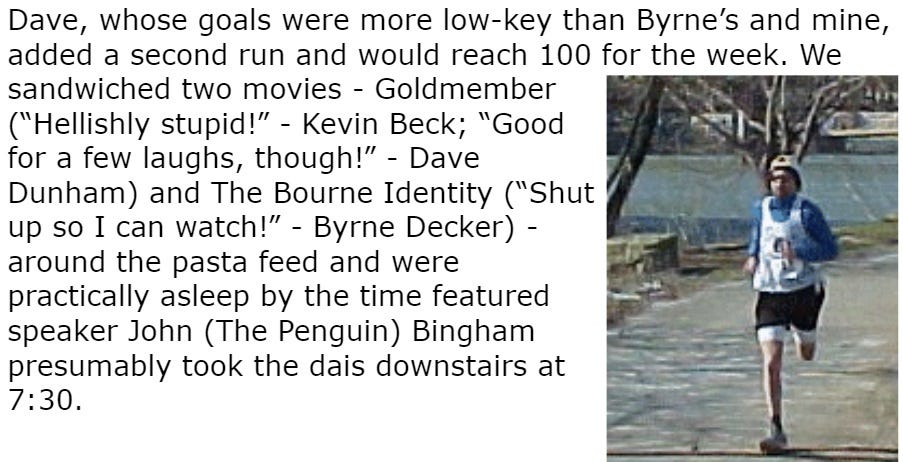Tempo runs, continued
We can play with both the overall pace of tempo runs and their within-run progression. So how fast is too fast for a tempo run, and how much threshold-like training is too much?
To return to a discussion I started the last time my pendulum had again swung fully from “Running is for suckers” to “Yay running,” and ignoring everything since while accepting that these peaks and troughs are part of an established psycho-creative pattern:
I never ran a faster 42.195K race than the 2:24:17 I recorded at the 2001 Boston Marathon. I didn’t run one at all that fall, when I was instead mostly glued to the television set slobbering over post-9/11 coverage, bottle often in hand. Over the winter of 2001-2002, bottle aside for a while, I logged an admittedly overzealous amount of mileage at the expense of any real speedwork, putting in 1,400 miles in a ten-week period with back-to-back weeks of 163 and 162 miles, including one 60-mile weekend.
Sadly, I didn’t get hurt or sick during this perambulation-bender, as this would have represented God doing for me what I could not do for myself. But I became a dead-legged idiot with a massive glycogen-to-CO2 footprint who was incapable of running much faster than 5:40 pace at all, even if I felt like I could run 6:00 pace all day. I was able to salvage a 2:28:28 marathon at Boston in 2002, a shade under 5:40 pace, without having done more than five kilometers in a row at that pace since sometime the previous year.
None of the results of this unplanned experiment should be mysterious to anyone.
I then ran 2:27:32 in December 2002 at the Rocket City Marathon in Huntsville, Alabama—once a Central Mass Striders tradition.
My preparation for this one included more restrained mileage levels than those I had allowed myself the previous winter, but few dedicated marathon-like workouts and a few aborted tempo runs. But shortly after that, I was connected with Pete Pfitzinger, who became my coach in exchange for my building and maintaining a coaching website for him (such sites were new features of the Internet-scape at the time).
Over the next few months, in trying to get into shape to run under 2:22:00 (the Olympic Marathon Team Trials qualifying standard at the time), I focused heavily on marathon-pace runs, medium-long runs with tempo portions incorporated within, and tune-up races. Most of those races went well, but were held on slow courses in wintry conditions. I did the last fifteen miles of a 20-miler on a flat stretch of road in at 5:24 pace.
Three weeks before Boston, at the end of a 123-mile week that included a Friday-night indoor 3,000-meters, I ran a 20-mile race spanning New Hampshire’s entire coastline. Alone in the rain after seven miles, I averaged 5:29 per mile, going out in 55:20 and coming back in 54:26, following Pete’s plan almost perfectly.
2:22:00 is 5:25 pace on the nose. I was probably ready to run under 2:22:00 on a favorable-weather day at Boston—no wind-boost needed, but little margin for weather-related or other obstacles, It proved to be a warm day—the first American male, a Belgian-born master who was suspended for doping the following year, ran 2:17-something, and the second finished in over 2:30:00—and I dropped out at around seven miles.
I would never again run a marathon with lofty expectations, though I did place second at the Disney World Marathon in January 2005 with a 2:28:31, running alone the entire way. But I did record most of my lifetime personal bests in a short burst of racing in the late winter and spring of 2004, when I was living in San Francisco.
The thing I remember most about my track training during this period was first getting serious about alternating pace workouts, such as 400 meters at 5K pace followed by 400 meters at marathon pace for around 12 laps in all.
This is probably what led to me to concoct some of the workouts that were featured for years in articles in corporate publications before I, for reasons that have yet to be explained to me, became a persona non grata among the low-wattage, spineless, pointless yutzes now running those outlets or their direct descendants, leading to the deletion of all of these articles. This will only lead to these workouts getting more exposure than they did the first time around, because their having been expunged from the official corporate record has given me a reason to again become interested in these articles and their principles and start writing about them here, which otherwise would never have happened.
General principles (to be augmented as the mood strikes and ebbs):
I don’t support the idea of “tempo intervals” for any experienced competitive runner.
An underemphasized goal or tempo-ish efforts is to home in on your current race pace across a variety of common distances.
People generally look at this from the other direction: I know my race pace for 5K, 10K, and the half-marathon, ergo my tempo-run pace is X.” But if you do a sustained run at 7:00 pace in the belief that this is your threshold pace, and find yourself feeling like you’re halfway through a 10K at the end of 20 minutes, you can learn something about your fitness while adding to it in a way more reminiscent of a time-trial than a threshold run.
If you want breaks, save them for repetition (interval) workouts. Incorporating any kind of rest into threshold days introduces an escape mechanism by encouraging an overzealous pace, and even in disciplined runners obliterates the rhythmic aspect of tempo runs that makes them not only valuable in training tired legs to stride out at ~180 steps per minute at a challenging-enough pace, but enticing when they’re going well.
Any sustained running you do between, say, 30-minute race pace and 90-minute race pace is sufficiently "threshold-like" to add value in the same way.
Because coaches are interested in the idea of cumulative stress and how much any given tempo run fatigues the engine and the chassis scoring the value of these should involve some combination of
1) the degree of gradual acceleration, or at least the absence of slowdown, indicating that most of the effort was clearly aerobic;
2) the duration (probably the most important); and
3) the surface. I used to do tempos almost solely on tracks, and for me this was very forgiving. Then again, I used to train in flats almost daily at times and have a shuffling sort of duck-with-ass-on-fire stride that helped prevent me from being a more accomplished runner, but also prevents a lot of pounding. But with the freedom GPS technology offers, people are doing road tempos and sometimes incorporating hills into these; these are nice add-ons, but they add recovery time in the same way doing a run on a soft track adds recovery time versus doing them on an Alter-G machine.
When I could run 51+ minutes for 10 miles, as was the case in that sweet stretch of 2004, any run I did lasting 20 or more minutes at an average pace of 5:05-ish to 5:20-ish per mile was very valuable. Sometimes I was running close to 5K pace for the last couple of minutes, but only if I got there without truly straining.
Finally, I cannot emphasize enough the importance of keeping a steady cadence throughout these workouts, so that pace modulation comes down to stride-length modulation.
This applies to any rest jogging you insist on doing on threshold days, as well as to the short, painful shuffles you do between hard 200-meter reps. Not allowing your cadence to lag has no aerobic cost and helps instill the kind of automatic commitment to forward motion that carries over into races.
Watch really, really good runners and what they do between hard portions of track workouts. If they wobble along knock-kneed, they’re either past their physical limit for a training setting or possibly over-vaccinated.



